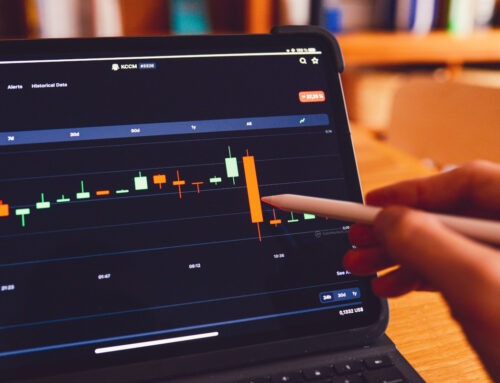If you’re going to be a successful trader, you’re going to need to master the art of timing your trades. Getting in and out of your positions at the right time can be the difference between 10% returns year over year or 30% returns year over year. When looking at individual trades, it can be the difference between making out with some profit or breaking even because you waited too long.
But, how do you know when to sell swing trading stocks?
That’s what you’re going to learn in this quick guide. We’re excited to talk about market timing, specifically, when to sell off your position and make off with some profit. This is an important topic because we see far too many new swing traders trying to squeeze out an extra 1-2% profit in their trades – only to wait too long and end up losing profit they already realized.
We’re going to go over the basic indicators you can watch to help you make informed decisions. But, we’re also going to share with you a little secret as to how you can start closing positions without any guesswork – timing the market with ease. Let’s get started!
Featured Courses:
Why Does Learning When To Sell Swing Trading Stocks Matter?
First things first – why does it matter when you sell a stock you are swing trading? The answer should be obvious. Proper timing can make all the difference in not just whether you end up winning or losing a trade – but the extent to which you win or lose your trade. We’re talking about profitability here.
Let’s say you buy 100 shares of company XYZ during a short dip in price at $10 a share. Over the next few days, the stock rises up to $14 a share. All your swing trading indicators are suggesting the stock is overbought and a price correction may be coming – should you sell now? Or, should you be aggressive and try and squeeze out a bit more profit? If you were to sell you’d realize profits of $400 in just a few short days – a really good return.
But say you didn’t sell – you got greedy and decided to ride it out another day or two. Well, company news came out overnight and when you woke up the next morning, you discovered the price had dropped down below your original purchase price of $10 a share. Not only did you not get a chance to realize that $400 profit – you end up losing money on the trade and wasting a few days of capital.
Being able to make emotionless decisions as to when to sell a stock you’re swing trading is an important skill. All swing traders will go through trial and error learning this. But, we’re here to help you avoid the costly mistakes of having to learn this lesson yourself. Let’s talk about how you can develop a swing trading strategy that minimizes risk and secures profits.
Swing Trading: When To Sell To Minimize Risk & Maximize Profits
We know one of the most common questions beginner swing traders ask is: when should I sell a stock I’m swing trading? And like most questions that pertain to swing trading, there is no one-size-fits-all answer. It depends on your risk tolerance – modest traders will sell stocks much sooner to take profits while aggressive traders may not be willing to sell for just 3-5% profits – they’ll wait out for 10%+ and take on the risk of never actually realizing that profit.
However, those small 3-5% returns add up over the course of a year – especially when trading larger position sizes. As such, we encourage all traders who are risk-averse to take profits when they can – or at least, take a portion of profits.
Selling Into Strength To Mitigate Risk
Selling into strength is a tactic some swing traders use to take profits while still enjoying some upside from a stock appreciating further. Say you have 100 shares of company XYZ. The price has risen 5% since you opened your position, and it is continuing to rise. But, your strategy is one of low risk. Should you sell off your shares now and take that 5% profit? Yes – but maybe not your entire position.
Instead, you could sell off half of your position. You’ll be left with 50 shares – and maybe the stock rises another 2-3% over the next day or two. You may be satisfied with this play and sell off the rest before the trend reverses. Or, you could sell off yet another half of your position – leaving in 25 shares to try and squeeze out additional profits.
Should the stock reverse and trend back towards the purchase price, you’re still positive – you’ve already taken profits to cover any small loss you may face on those remaining 25 shares before you sell them off. Not only will this type of selling strategy help you minimize risk while maximizing profits. But, it will also help you free up capital to use towards other opportunities as you squeeze the fruit for all its juice.
Using Indicators To Guage The Right Time To Sell Swing Trading Stocks
If you read our guide to swing trading for beginners, you learned that there are all sorts of indicators you can watch to help you time the market. These indicators will help you get a sense of when a stock is a good opportunity to enter, and when that same stock’s opportunity is closing and it is time to get out. There are three types of indicators worth using:
- Trend indicators
- Momentum indicators
- Volume indicators
You’ll use a combination of these indicators to influence your decision-making. But how can you specifically use these to determine when to sell swing trading stocks? One of the most simple ways is to use volume indicators to help you determine whether a stock is overbought or oversold. If you’re in a position and see the stock is way overbought, chances are, a price correction is coming. Monitor the RSI, Bollinger bands, and MACD to predict reversals and get out of your position before it’s too late. Learn more about the best swing trading indicators in our blog.
Want To Make It Easy To Know When To Sell Swing Trading Stocks?
Even the most experienced traders get sick of technical analysis – it can get convoluted and confusing. If you want to make it easy to know when to sell a stock you are swing trading, traditional technical analysis is not the best approach. In fact, it’s outdated. These days, things can be far easier if you are willing to invest in a stock forecasting tool like VectorVest.
Don’t you wish you had a seasoned expert standing over your shoulder to give you simple recommendations as to when to buy, sell, or hold a given stock? That’s exactly what VectorVest does. We’ve been timing the market with great accuracy for decades – our track record speaks for itself. We can help you make emotionless, accurate decisions as to when you should sell your stock. We simplify all indicators for you to make things as simple as possible.
But that’s not all – the software also brings you winning opportunities on autopilot. Just pull up our hot stocks list each morning – or any of our other lists – and find opportunities that fit your trading strategy. It couldn’t be easier – and you’ll start winning more trades and become more profitable. How great does that sound?
Final Thoughts On When To Sell A Stock You’re Swing Trading
As you can see, learning when to sell a stock you’re swing trading isn’t all that complicated. To limit your risk you should take profits whenever possible. There are plenty of indicators that can help you predict reversals and get out of your position at just the right time – but if you want to increase your chances of success and transform the way you trade, invest in quality stock forecasting software. You won’t regret it – especially when you see your profits soar. Try it out yourself risk-free for 30-days!








Leave A Comment